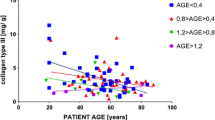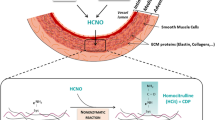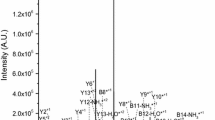Abstract
Non-enzymatic glycation of proteins is one of the key mechanisms in the pathogenesis of diabetic complications and may be significant in the age-related changes of tissues. We investigated thein vitro glycation of human aortic α-elastin, and chose and adapted methods for evaluating the degree and kinetics of glycation. α-Elastin was prepared from thoracic aortas of young accident victims and glycated by incubating with different glucose concentrations (25, 50, 75 and 100 mmol/l) in 0.2 M phosphate buffer, pH 7.8 for 30 days, at 37°C. The degree of glycation was measured by three colorimetric methods,i.e. Nitroblue tetrazolium, 2-thiobarbituric acid and hydrazine; by aminophenyl-boronate affinity chromatography which determines Amadori products; and by a fluorescence method which determines advanced glycosylation end products. The highest degree of glycation was found on day 3 after the beginning of incubation. Fluorescence, as an index of advanced glycation, consistently increased from days 5 to 24. Investigation of the properties of glycated elastin may help in understanding the importance of this long-lived protein for the age-related changes in tissues and for diabetic complications.
Similar content being viewed by others
References
Cerami A. Hypothesis — glucose as a mediator of aging.J Am Ger Soc 1985:33; 624–34.
Kristal B, Bung P. An emerging hypothesis; induction of aging by free radical and Maillard reaction.J Gerontol 1992:47; B107-B111.
Kennedy L, Beynos JW. Non-enzymatic glycosylation and the chronic complications of diabetes: an overview.Diabetologia 1984:26; 93–8.
Vlassara H, Brownlee M, Cerami A. Non-enzymatic glycosylation: role in the pathogenesis of diabetic complications.Clin Chem 1986:32; B37-B41.
Trivelli LA, Kanney HM, Lai HT. Hemoglobin components in patients with diabetes mellitus.New Engl J Med 1971:284; 353–7.
Bunn HF. Structural heterogeneity of human HbA due to nonenzymatic glycosylation.Biol Chem 1979:254; 3892–8.
McDonald NH. Glycosylated minor components of human adult hemoglobin.J Biol Chem 1978:253; 2327–37.
Miller JA, Gravalles E, Bunn HF. Non-enzymatic glycosylation of erythrocyte membrane proteins.J Clin Invest 1980:65; 896–901.
Kirstein M, Brett J, Radoff J, et al. Advanced protein glycosylation induces transendothelial human monocyte chemotaxis and secretion of platelet-dirived growth factor: role in vascular disease of diabetes and aging.Proc Natl Acad Sci USA 1990:87; 9010–4.
Calvo C, Luo BY, Puygranier F, et al. Characterization and metabolism of glycated HDL in diabetic patients.Adv Exp Med Biol 1988:243; 165.
Brownless M, Vlassara H, Cerami A. Inhibition of heparin catalyzed human antithrombin III activity by nonenzymatic glycosylation: possible role in fibrin deposition in diabetes.Diabetes 1984:33; 532–5.
Coradello H, Lubee G, Pollack A, Sternberg M. Enzyme activities of native non-enzymatically glycosylated trypsin, chymotrypsin and papain.Paediar Paedol 1982:17; 457–64.
Dolhofer R, Wicland OH. Preparation and biological properties of glycosylated insulin.FEBS Lett 1979:100; 133–6.
Trueb B, Fluckiger R, Winterhalter KH. Nonenzymatic glycosylation of basement membrane collagen in diabetes mellitus.Collagen Rel Res 1984:4; 239–51.
Kohn RR, Schnider SL. Glycosylation of human collagen.Diabetes 1982:31 (suppl 3); 47–51.
Vishwanath V, Frank KF, Elmetes, et al. Glycation of skin collagen in type I diabetes mellitus.Diabetes 1986:35; 916–921.
Schnider SL, Kohn RR. Effects of age and diabetes mellitus on the solubility and nonenzymatic glycosylation of human skin collagen.J Clin Invest 1981:67; 1630–5.
Monnier VM, Kohn RR, Cerami A. Accelerated age-related browning of human collagen in diabetes mellitus.Proc Natl Acad Sci USA 1984:81; 583–7.
Stevens VJ, Rouzer CA, Monnier VM, Cerami A. Diabetic cataract formation: potential role of glycosylation of lens crystalins.Proc Natl Acad Sci USA 1978:75; 2918–22.
Tarsio JF, Roger LA, Furcht LT. Decreased interaction of fibronectin, type IV collagen and heparin due to nonenzymatic glycation. Implications for diabetes mellitus.Biochemistry 1987:26; 1014–20.
Charonis AS, Tsilibary EC. Structural and functional changes of laminin and type IV collagen after non-enzymatic glycation.Diabetes 1992:41; 49–51.
Greene DA. Metabolic abnormalities in diabetic peripheral nerve: relation to impaired function.Metabolism 1980:92; 118–23.
Starcher BC, Galione MJ. Purification and comparison of elastins from different animal species.Anal Biochem 1976:74; 441–7.
Partridge SM, Davis HF, Adair GS. The chemistry of connective tissues soluble proteins derived from partial hydrolysis of elastin.Biochem J 1955:61; 11–15.
Johnson RN, Metcalf PA, Baker JR. Fructosamine: a new approach to the estimation of serum glycosylprotein. An index of diabetic control.Clin Chim Acta 1982:127; 87–95.
McFaraland, Cataland KF, Day JF, et al. Nonenzymatic glycosylation of serum proteins in diabetes mellitus.Diabetes 1979:28; 1011–4.
Kennedy AL, Mehl TD, Merimee TJ. Non-enzymatic glycosylated serum protein: spurious elevation due to free glucose in serum.Diabetes 1980:29; 413–5.
Ma A, Naughton A, Cameron DP. Glycosylated plasma protein: a simple method for the elimination of interference by glucose in its estimation.Clin Chim Acta 1981:115; 111–7.
Kobayashi K, Yoshimoto K, Hirauchi K, Uchida K. Novel determination of glycated proteins in biological samples.Clin Chem 1992:38; 1999.
Mallia AK, Hermanson GT, Krohn RL, et al. Preparation and use of a boronic acid affinity support for separation and quantitation of glycosylated hemoglobin.Analyt Lett. 1981:14; 649.
Sedmak JJ, Crossberg SE. A rapid sensitive and versatile assay for protein using Coomassie Brilliant Blue G250.Anal Biochem 1977:79; 544–52.
Fu MX, Knecht KJ, Thorpe SR, Baynes JW. Role of oxygen in cross-linking and chemical modification of collagen by glucose.Diabetes 1992:41; 42–8.
Bitensky MW, Kowluru A, Kowluru RA. Nonenzymatic glycation and protein recognition. In: Baynes JW, Monnier VM, eds.The Maillard Reaction in Aging, Diabetes and Nutrition. New York: Alan R Liss, 1989; 185–204.
Author information
Authors and Affiliations
Rights and permissions
About this article
Cite this article
Baydanoff, S., Konova, E., Dosheva, I. et al. Non-enzymatic glycation of elastin. Glycosylation & Disease 1, 53–58 (1994). https://doi.org/10.1007/BF00917469
Received:
Accepted:
Published:
Issue Date:
DOI: https://doi.org/10.1007/BF00917469




